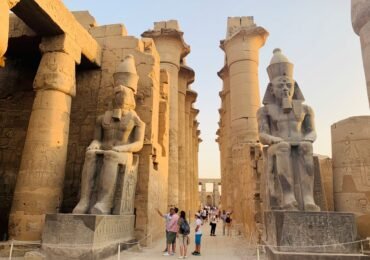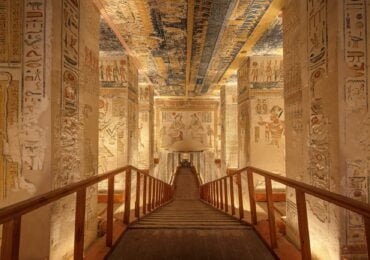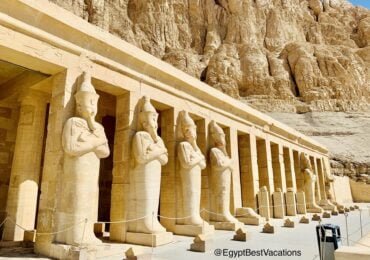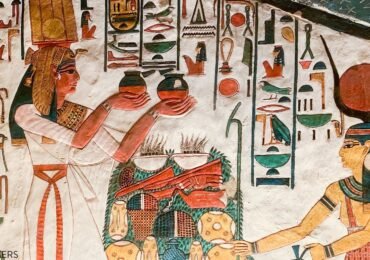Embark on an exciting journey though the must-see attractions in Luxor, Egypt. Nestled gracefully along the timeless banks of the Nile River. Luxor serves as a testament to the splendor of ancient Egyptian civilization. Once known as Thebes in antiquity. Luxor unravels a rich tapestry of archaeological wonders. They beckoning visitors to journey through the corridors of history. From awe-inspiring temples to opulent tombs. This city is a haven for history enthusiasts and adventure seekers alike. Let’s embark on a virtual exploration, uncovering the captivating attractions that render Luxor an unparalleled destination.
Related topic: History of Luxor
Wandering through the streets of Luxor reveals a city where each stone and carving whispers tales of conquests, dynasties, and the ever-flowing vitality of the Nile. Luxor’s deep-rooted history echoes the narratives of ancient rulers, religious rites, and the daily rhythm of a civilization that flourished along the riverbanks.
List of the must-see attractions in Luxor
1. Karnak Temple Complex
Number-one site of the must-see attractions in Luxor is the Karnak Temple. The Temple/Complex of Karnak was the great god’s chief sanctuary and much larger than any other monument in Egypt. This huge and splendid complex which actually contains many separate temples covers 1700 years of expansion and an area of 300 acres. Beneath its giant architraves and between the bulky columns and wall reliefs are records of its history. The temple expanded from a modest Middle Kingdom shrine to a magnificent temple of vast proportions. It owes a column to one pharaoh, a pylon to another; an inspiration here, a whim there. But each has the sole purpose of honoring the god Amun-Re. Who would then ensure the builder a long, powerful, and glorious life.
Read more: Karnak Temple
Related topic: Luxor Day Tours
2. Luxor Temple

The Temple of Luxor was built by the 18th Dynasty pharaoh Amenhotep III (1387-1349 BCE). He is the grandson of the military genius Tuthmosis III, and expanded by the 19th Dynasty pharaoh Ramses II (1279-1213 BCE). Numerous other sovereigns, including Tutankhamun, Horemhab, and Alexander the Great enriched the construction with reliefs, inscriptions, and minor buildings.
The temple was built for the glory of Amun-Re, King of all gods. Which was called by the Ancient Egyptians the “Southern Harem of Amun”. Most of the complex is well preserved, particularly the wall reliefs. It was covered in sand and built over by the town until excavations started in 1885 by Gaston Maspero. The structure follows the classic of the pharaonic temples. The pavement progressively rises and the roof declines from the entrance to the inner sanctuary
Read more: Luxor Temple
Related tour: Tour to Karnak & Luxor temples
3. Valley of the Kings

Valley of the Kings is not just one of the must-see attractions in Luxor but also is one of the great highlights of Egypt. The Ancient Egyptians named it (Ta-Iset-Ma’at), which means “the Place of Truth”. The Valley of the Kings is the necropolis of the great Egyptian pharaohs of the 18th to the 20th Dynasty (1550-1080 BCE). Tuthmosis I was the first pharaoh who was buried at the Valley of the Kings. While Ramses XI was the last pharaoh who was buried there.
The story of the Valley of the Kings begins when the pharaohs ceased building new pyramids. Therefore pharaohs decided to separate their tombs from their mortuary temples. The first pharaoh to do so was Tuthmosis I. His chief architect Ineni excavated a shaft tomb in a lonely ravine. He cut a steep stairway into the rock, and at its bottom the burial chamber. This plan was followed by all the later pharaohs for 500 years.
Read more: Valley of the Kings
4. Hatshepsut Temple

Through building projects, Hatshepsut assured divine favor and prosperity for her and her people. She proved that she was a responsible ruler securing the best for Egypt. Queen Hatshepsut, more a patron of the arts than a military leader. She ordered a funerary monument for her father Tuthmosis I, and for herself. Hatshepsut chose an impervious valley already consecrated to the goddess Hathor who received the deceased in the underworld.
Queen Hatshepsut’s monument was in later times abandoned. At a certain point in history it became a Christian convent called the Convent of the North. This fact not only gave the area its present name of Deir El-Bahari but also preserved the pharaonic temple from further destruction.
Read more: Hatshepsut Temple
5. Colossi of Memnon
In the vast plain that stretches out around western Thebes, between the Nile and the Valley of the Kings. There are remains of the monumental road which led to the mortuary temple of Amenhotep III. The Colossi of Memnon are all that remain of what was once the largest mortuary temple on the west bank of Luxor. The temple, unfortunately, has disappeared – probably from a high flood. As well, it was devastated by Ramses II and his son Merenptah, who used the fallen blocks to build their own temples – commonly known by the names of Colossi of Memnon.
Read more: Colossi of Memnon
Related tour: Tour to Kings Valley, Hatshepsut Temple and Colossi of Memnon
6. Valley of the Queens
Adjacent to the illustrious Valley of the Kings, the Valley of the Queens unveils itself as a tranquil resting place for Egypt’s queens and their royal offspring. This peaceful expanse, nestled within the rocky embrace of the desert, offers a subdued contrast to the grandeur of its nearby counterpart. Here, beneath the sun’s arid gaze, lies a silent tribute to the women and children who played pivotal roles in Egypt’s royal lineage.

Among the array of tombs in the Valley, the Tomb of Nefertari shines as a distinctive masterpiece. It is celebrated for its unmatched craftsmanship and meticulous detail. This tombs is one of the great must-see attractions in Luxor but require an extra fee of 1600 L.E. Nefertari, the cherished wife of Pharaoh Ramses II, was renowned for her beauty and intellect. Her tomb mirrors the opulence and sophistication of Egyptian royalty, presenting intricate depictions of the queen in various divine and earthly roles.
Related tour: Tour to Queens Valley, Habu Temple and Deir El-Madinah
7. Medinet Habu Complex
On the serene expanse of the Nile’s west bank, Medinet Habu rises as a vast temple complex, dedicated to the formidable Ramses III. Beyond its remarkable architecture, Medinet Habu serves as a living testament, offering a glimpse into the military triumphs and cultural richness of ancient Egypt. As you step onto this sacred ground, prepare to immerse yourself in the grandeur and historical resonance that has defined this site for centuries.
At the heart of Medinet Habu rests the Mortuary Temple of Ramses III. A monumental structure serving both as a place of worship and a commemoration of the pharaoh’s rule. As you step into its sacred spaces, be captivated by the intricacy of the carvings and the spiritual ambiance that saturates the atmosphere. The temple isn’t just a physical structure; it’s a conduit across time, bridging today’s visitors with the religious rituals and beliefs of ancient Egypt.
8. Deir El-Madina – Valley of Artisans
Nestled on the west bank of the Nile, away from the grandeur of temples and tombs, lies a hidden gem that unveils the daily life and artistic prowess of ancient Egypt – Deir El-Madina, often referred to as the Valley of Artisans.
Deir El-Madina served as a bustling community of skilled craftsmen and laborers during the New Kingdom period. These artisans were responsible for constructing the elaborate tombs of pharaohs and nobility in the nearby Valley of the Kings and Valley of the Queens. What sets this site apart is its intimate portrayal of daily life. From the modest homes of the artisans to the communal spaces where they shared their stories and dreams.
Related tour: Tour to Queens Valley, Habu Temple and Deir El-Madinah
9. Ramesseum Temple
Situated on the tranquil west bank of the Nile, the Ramesseum, often recognized as the “Mortuary Temple of Ramses II”. It is a colossal testament to the lasting influence of one of Egypt’s most formidable pharaohs. Beyond its imposing exterior, this grand edifice invites visitors to journey back in time. Marveling at the remnants of a colossal statue that once embodied the power and authority of Ramses II.
The Ramesseum extends an invitation to all, guiding them through the passages of time. Where its colossal remnants and intricate reliefs serve as gateways to an era when pharaohs shaped destinies. Whether one is a history enthusiast or a casual wanderer. The Ramesseum promises an immersive encounter, a chance to witness the echoes of a glorious past and admire architectural feats that have withstood centuries.
Related tour: Tour to Ramesseum, Nobles Tombs and Deir El-Madinah
10. Tombs of Nobles in Luxor
Situated on the west bank of the Nile, the Tombs of Nobles in Luxor unveil a captivating expedition into the private domains of ancient Egypt’s elite. Removed from the opulence of the pharaohs’ resting places. These concealed treasures present a distinctive viewpoint on the lives and legacies of the nobility who once graced the landscapes of ancient Thebes.
Stepping into the Tombs of Nobles immerses you in an atmosphere of sophistication. These sepulchers, adorned with intricate carvings and lively frescoes. They recount the stories of governors, priests, and esteemed officials who significantly shaped Luxor’s destiny. Unlike the grandeur of royal tombs, the Tombs of Nobles offer a more personal insight into the daily routines, beliefs, and aspirations of the elite class.
Related tour: Tour to Ramesseum, Nobles Tombs and Deir El-Madinah
11. Luxor Museum
If you want to indulge not just in the must-see attractions of Luxor but history of Egypt, then visit Luxor Museum. For a more profound connection with Egypt’s captivating history, a visit to the Luxor Museum is a journey into the heart of antiquity. This contemporary repository of ancient treasures opens a curated portal, inviting you to explore the intricacies of life, art, and culture in ancient Egypt.
Upon entering the Luxor Museum, you will find yourself in the presence of treasures once buried alongside Tutankhamun. The collection boasts an array of meticulously preserved artifacts, providing insights into the grandeur and rituals of ancient Egyptian burial customs. From intricately crafted jewelry to ceremonial objects, each piece narrates a chapter of a civilization deeply rooted in reverence for the afterlife.
Related tour: Tour to Luxor & Mummification museums
12. Mummification Museum
Embark on an enthralling exploration into the ancient tradition of mummification at Luxor’s Mummification Museum. Situated on the tranquil west bank of the Nile, this exceptional museum stands as a tribute to the precise craftsmanship and scientific ingenuity that preserved departed souls for the journey beyond.
Marvel at the impeccably preserved artifacts showcased, ranging from genuine mummies to the instruments utilized by skilled embalmers. Each exhibit unfolds a narrative from an era long past, illuminating the beliefs and customs that enshrouded death and the voyage to the afterlife. The museum’s collection acts as a portal into the profound reverence ancient Egyptians held for the continuation of existence beyond mortal boundaries.
Related tour: East Bank Tour Package
13. Karnak Sound & Light Show
As the sun sets in Luxor, the Karnak Temples undergo a magical transformation, painting an enchanting picture of ancient history. The Karnak Sound & Light Show orchestrates a captivating display, where the interplay of light, sound. Enduring splendor of Egypt’s past unfolds in a mesmerizing nighttime experience.
As darkness descends, Karnak takes on a mystical aura. Sound & Light Show offers a unique opportunity to witness the temples in a new light – quite literally. Bathed in carefully choreographed lights, the colossal structures and intricate details become a living canvas, narrating the captivating story of ancient Egypt.
Related tour: Tour to Karnak Sound & Light Show
Conclusion
Luxor is a tapestry of ancient wonders, each site of these must-see attractions in Luxor. They weaving a unique story of the pharaohs, gods, and the enduring spirit of the Egyptian civilization. From the monumental temples to the intimate museums, every corner of Luxor reveals a piece of the past. As you wander through the shadows of these timeless structures, you will find yourself immersed in the magic of Luxor. A destination that beckons both history enthusiasts and modern-day explorers to uncover the secrets of Egypt’s glorious past. Plan your journey wisely, for Luxor is not just a city; it’s a living history book waiting to be read by those with a passion for discovery.

